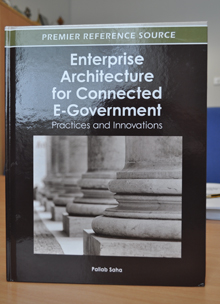Dr. Pallab Saha’s fourth book, Enterprise Architecture for Connected E-Government: Practices and Innovations, plugs a huge gap in current literature in terms of linking and understanding the relationship between e-government and government enterprise architecture.
In fact, there is no book currently in the market that examines the role enterprise architecture plays in e-government, said Dr Saha, an Evangelist with the Enterprise Architecture Practice at ISS.
“There exists very generic e-government books but this is the only book that focuses on enterprise architecture for governments. Indeed there is a dearth of literature demonstrating field tested concepts substantiated with real examples of countries embracing enterprise architecture and its role in realising the vision of connected government.”
The book was so special that it was announced on the United Nations’ website when it was first released in June 2012.
Enterprise Architecture is defined as the ongoing process of building the ability to tackle complexity, with the goal of creating and sustaining coherent enterprises. The strongest driver for Enterprise Architecture is to improve service delivery and overall performance within an organisation.
 The book examines the role enterprise architecture plays in e-government initiatives across the globe, including Bulgaria, Bahrain, Denmark, Saudi Arabia and the American city of Tacoma.
The book examines the role enterprise architecture plays in e-government initiatives across the globe, including Bulgaria, Bahrain, Denmark, Saudi Arabia and the American city of Tacoma.
The volume first took shape as a 70-page project funded by Microsoft in 2010. When the published document was made available online by the United Nations, it was much downloaded. This encouraged Dr. Saha to write the book.
Reception to the book has been warm, said Dr. Saha. “Many countries are finding it very useful because there is no similar book in the market for government agencies to refer to. In addition, 70% of this book covers case studies, so from a practitioner’s point of view, it is very useful.”
Among those who found the book useful was Dr. Nguyen Thanh Phuc, the Vice-Chairman Director General of the Authority of Information Technology Application at the Vietnam Ministry of Information and Communication. He said, “By discussing theoretical and practical innovations, best lessons and their impact on transforming from fragmented government to government-as-a-whole, the book is expected to attract authorities in making polices and strategies to actively respond to the higher demands from public management and human development, as well as to overcome massive financial and economic challenges the in coming period. In the case of Vietnam, the book helps us find appropriate solutions to resolve the situations of ineffective cross-agency and inter-agency collaborations, unsuitable mechanisms in allocating and distributing the state budget, and insufficiently shared infrastructure nationwide.”
This article is first published in NUS-ISS quarterly e-newsletter, Issue 3 (Jul-Sep 2013).